2006 MERCEDES-BENZ SPRINTER lock
[x] Cancel search: lockPage 1805 of 2305
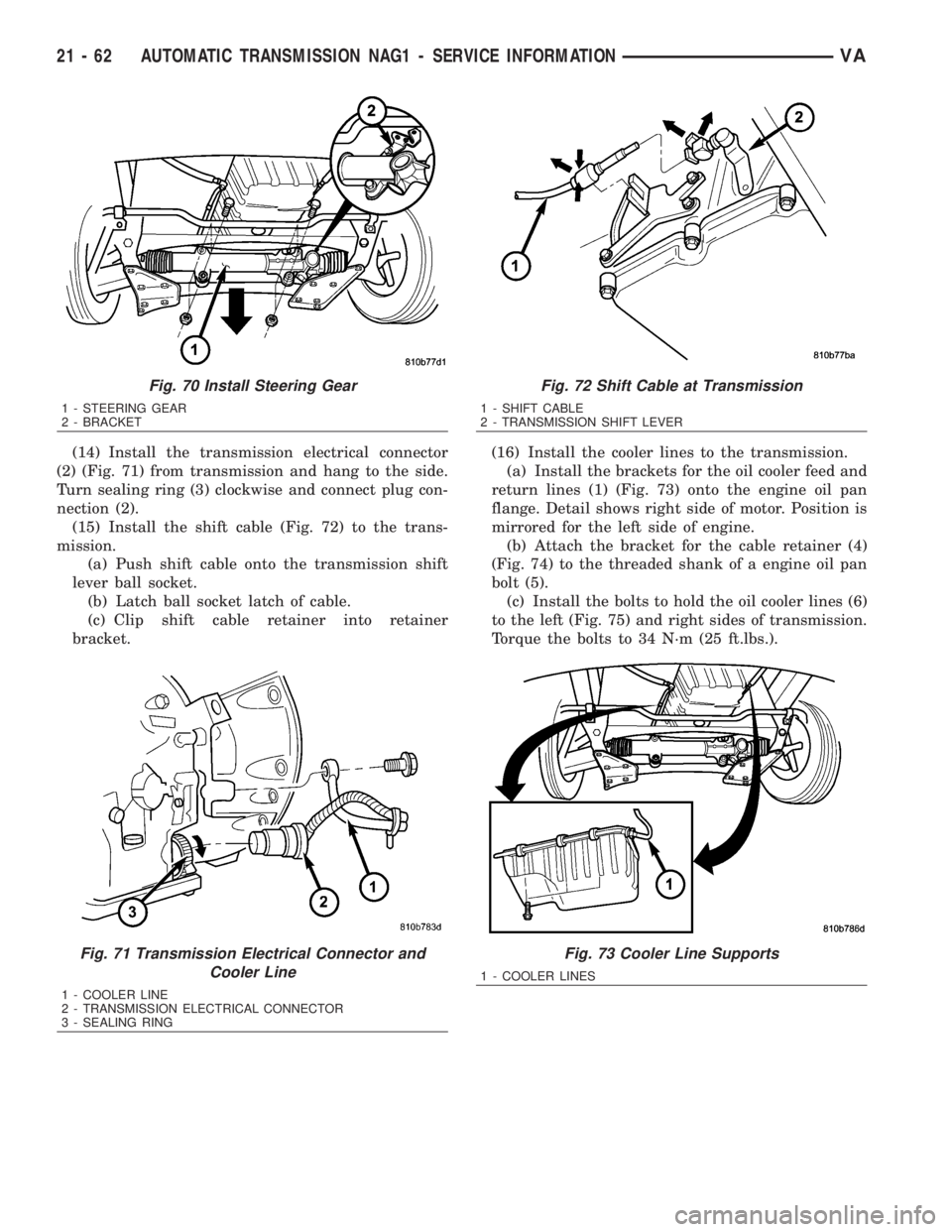
(14) Install the transmission electrical connector
(2) (Fig. 71) from transmission and hang to the side.
Turn sealing ring (3) clockwise and connect plug con-
nection (2).
(15) Install the shift cable (Fig. 72) to the trans-
mission.
(a) Push shift cable onto the transmission shift
lever ball socket.
(b) Latch ball socket latch of cable.
(c) Clip shift cable retainer into retainer
bracket.(16) Install the cooler lines to the transmission.
(a) Install the brackets for the oil cooler feed and
return lines (1) (Fig. 73) onto the engine oil pan
flange. Detail shows right side of motor. Position is
mirrored for the left side of engine.
(b) Attach the bracket for the cable retainer (4)
(Fig. 74) to the threaded shank of a engine oil pan
bolt (5).
(c) Install the bolts to hold the oil cooler lines (6)
to the left (Fig. 75) and right sides of transmission.
Torque the bolts to 34 N´m (25 ft.lbs.).
Fig. 70 Install Steering Gear
1 - STEERING GEAR
2 - BRACKET
Fig. 71 Transmission Electrical Connector and
Cooler Line
1 - COOLER LINE
2 - TRANSMISSION ELECTRICAL CONNECTOR
3 - SEALING RING
Fig. 72 Shift Cable at Transmission
1 - SHIFT CABLE
2 - TRANSMISSION SHIFT LEVER
Fig. 73 Cooler Line Supports
1 - COOLER LINES
21 - 62 AUTOMATIC TRANSMISSION NAG1 - SERVICE INFORMATIONVA
Page 1834 of 2305
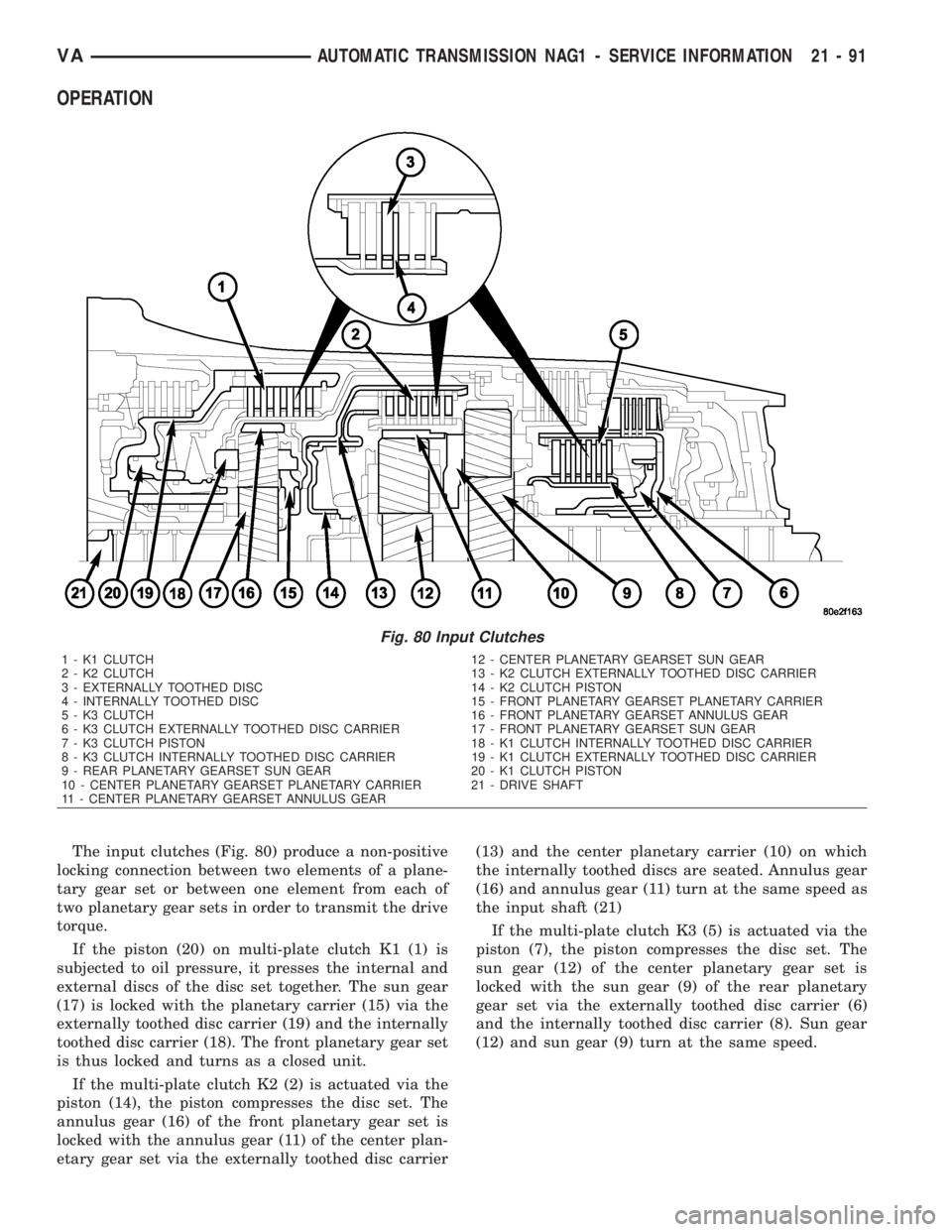
OPERATION
The input clutches (Fig. 80) produce a non-positive
locking connection between two elements of a plane-
tary gear set or between one element from each of
two planetary gear sets in order to transmit the drive
torque.
If the piston (20) on multi-plate clutch K1 (1) is
subjected to oil pressure, it presses the internal and
external discs of the disc set together. The sun gear
(17) is locked with the planetary carrier (15) via the
externally toothed disc carrier (19) and the internally
toothed disc carrier (18). The front planetary gear set
is thus locked and turns as a closed unit.
If the multi-plate clutch K2 (2) is actuated via the
piston (14), the piston compresses the disc set. The
annulus gear (16) of the front planetary gear set is
locked with the annulus gear (11) of the center plan-
etary gear set via the externally toothed disc carrier(13) and the center planetary carrier (10) on which
the internally toothed discs are seated. Annulus gear
(16) and annulus gear (11) turn at the same speed as
the input shaft (21)
If the multi-plate clutch K3 (5) is actuated via the
piston (7), the piston compresses the disc set. The
sun gear (12) of the center planetary gear set is
locked with the sun gear (9) of the rear planetary
gear set via the externally toothed disc carrier (6)
and the internally toothed disc carrier (8). Sun gear
(12) and sun gear (9) turn at the same speed.
Fig. 80 Input Clutches
1 - K1 CLUTCH 12 - CENTER PLANETARY GEARSET SUN GEAR
2 - K2 CLUTCH 13 - K2 CLUTCH EXTERNALLY TOOTHED DISC CARRIER
3 - EXTERNALLY TOOTHED DISC 14 - K2 CLUTCH PISTON
4 - INTERNALLY TOOTHED DISC 15 - FRONT PLANETARY GEARSET PLANETARY CARRIER
5 - K3 CLUTCH 16 - FRONT PLANETARY GEARSET ANNULUS GEAR
6 - K3 CLUTCH EXTERNALLY TOOTHED DISC CARRIER 17 - FRONT PLANETARY GEARSET SUN GEAR
7 - K3 CLUTCH PISTON 18 - K1 CLUTCH INTERNALLY TOOTHED DISC CARRIER
8 - K3 CLUTCH INTERNALLY TOOTHED DISC CARRIER 19 - K1 CLUTCH EXTERNALLY TOOTHED DISC CARRIER
9 - REAR PLANETARY GEARSET SUN GEAR 20 - K1 CLUTCH PISTON
10 - CENTER PLANETARY GEARSET PLANETARY CARRIER 21 - DRIVE SHAFT
11 - CENTER PLANETARY GEARSET ANNULUS GEAR
VAAUTOMATIC TRANSMISSION NAG1 - SERVICE INFORMATION 21 - 91
Page 1848 of 2305
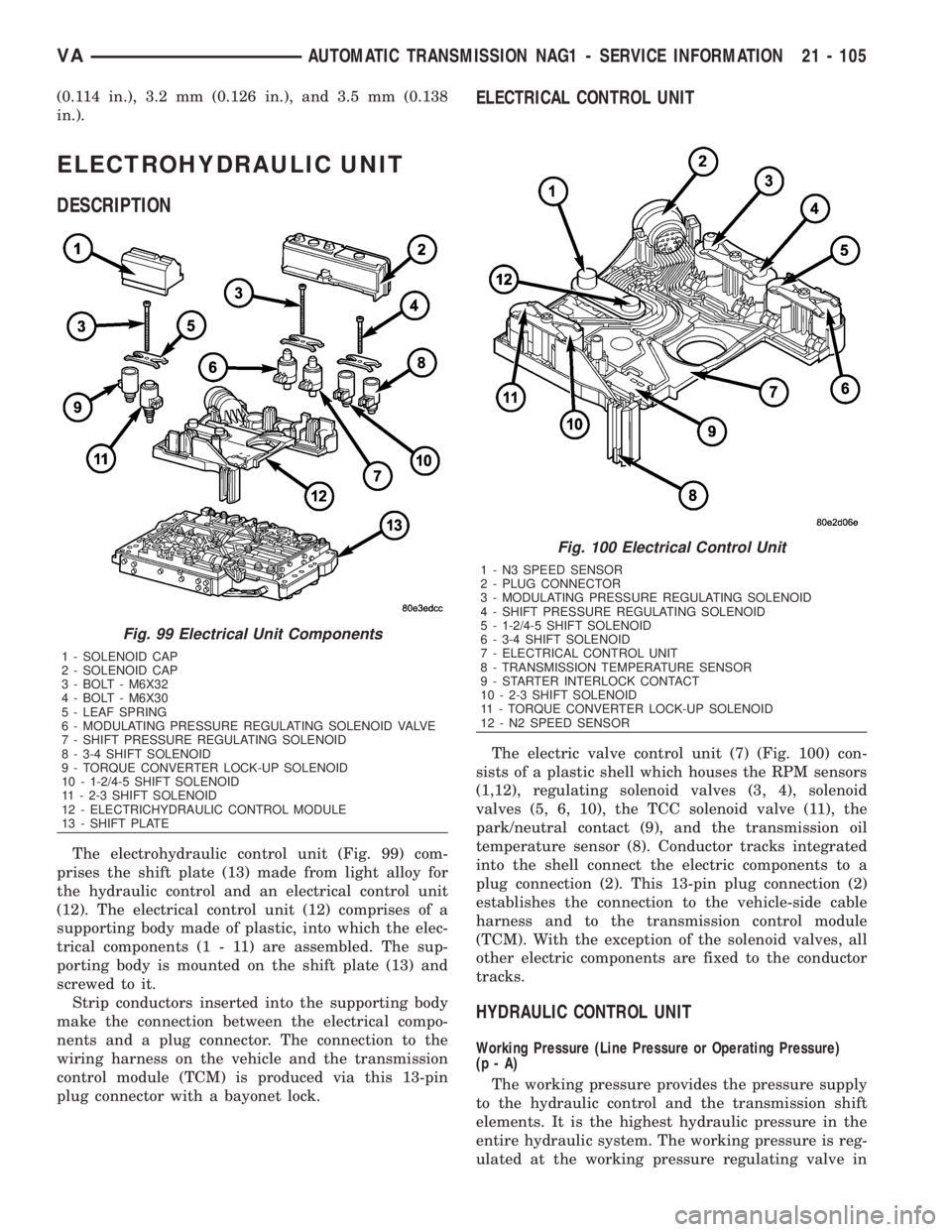
(0.114 in.), 3.2 mm (0.126 in.), and 3.5 mm (0.138
in.).
ELECTROHYDRAULIC UNIT
DESCRIPTION
The electrohydraulic control unit (Fig. 99) com-
prises the shift plate (13) made from light alloy for
the hydraulic control and an electrical control unit
(12). The electrical control unit (12) comprises of a
supporting body made of plastic, into which the elec-
trical components (1 - 11) are assembled. The sup-
porting body is mounted on the shift plate (13) and
screwed to it.
Strip conductors inserted into the supporting body
make the connection between the electrical compo-
nents and a plug connector. The connection to the
wiring harness on the vehicle and the transmission
control module (TCM) is produced via this 13-pin
plug connector with a bayonet lock.
ELECTRICAL CONTROL UNIT
The electric valve control unit (7) (Fig. 100) con-
sists of a plastic shell which houses the RPM sensors
(1,12), regulating solenoid valves (3, 4), solenoid
valves (5, 6, 10), the TCC solenoid valve (11), the
park/neutral contact (9), and the transmission oil
temperature sensor (8). Conductor tracks integrated
into the shell connect the electric components to a
plug connection (2). This 13-pin plug connection (2)
establishes the connection to the vehicle-side cable
harness and to the transmission control module
(TCM). With the exception of the solenoid valves, all
other electric components are fixed to the conductor
tracks.
HYDRAULIC CONTROL UNIT
Working Pressure (Line Pressure or Operating Pressure)
(p-A)
The working pressure provides the pressure supply
to the hydraulic control and the transmission shift
elements. It is the highest hydraulic pressure in the
entire hydraulic system. The working pressure is reg-
ulated at the working pressure regulating valve in
Fig. 99 Electrical Unit Components
1 - SOLENOID CAP
2 - SOLENOID CAP
3 - BOLT - M6X32
4 - BOLT - M6X30
5 - LEAF SPRING
6 - MODULATING PRESSURE REGULATING SOLENOID VALVE
7 - SHIFT PRESSURE REGULATING SOLENOID
8 - 3-4 SHIFT SOLENOID
9 - TORQUE CONVERTER LOCK-UP SOLENOID
10 - 1-2/4-5 SHIFT SOLENOID
11 - 2-3 SHIFT SOLENOID
12 - ELECTRICHYDRAULIC CONTROL MODULE
13 - SHIFT PLATE
Fig. 100 Electrical Control Unit
1 - N3 SPEED SENSOR
2 - PLUG CONNECTOR
3 - MODULATING PRESSURE REGULATING SOLENOID
4 - SHIFT PRESSURE REGULATING SOLENOID
5 - 1-2/4-5 SHIFT SOLENOID
6 - 3-4 SHIFT SOLENOID
7 - ELECTRICAL CONTROL UNIT
8 - TRANSMISSION TEMPERATURE SENSOR
9 - STARTER INTERLOCK CONTACT
10 - 2-3 SHIFT SOLENOID
11 - TORQUE CONVERTER LOCK-UP SOLENOID
12 - N2 SPEED SENSOR
VAAUTOMATIC TRANSMISSION NAG1 - SERVICE INFORMATION 21 - 105
Page 1849 of 2305
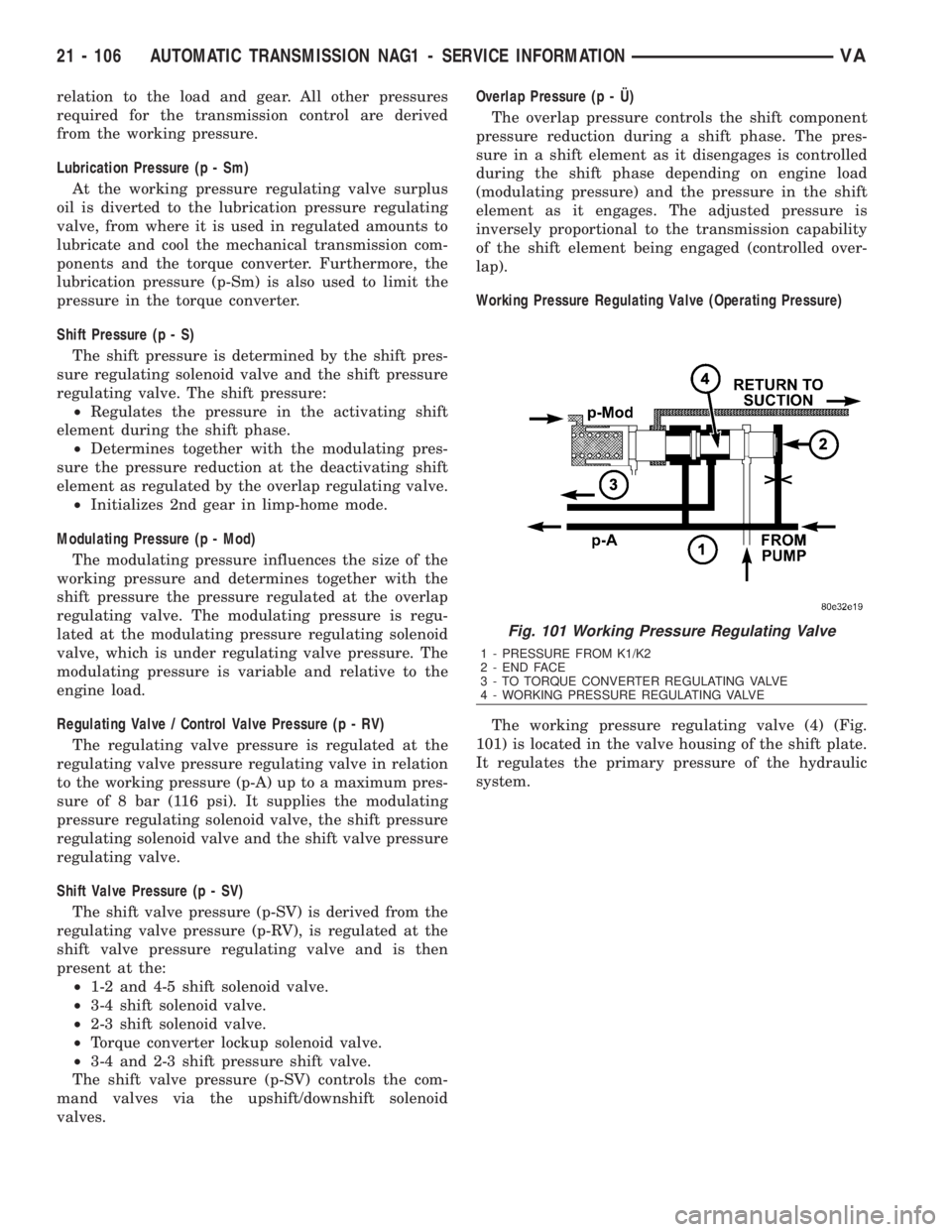
relation to the load and gear. All other pressures
required for the transmission control are derived
from the working pressure.
Lubrication Pressure (p - Sm)
At the working pressure regulating valve surplus
oil is diverted to the lubrication pressure regulating
valve, from where it is used in regulated amounts to
lubricate and cool the mechanical transmission com-
ponents and the torque converter. Furthermore, the
lubrication pressure (p-Sm) is also used to limit the
pressure in the torque converter.
Shift Pressure (p - S)
The shift pressure is determined by the shift pres-
sure regulating solenoid valve and the shift pressure
regulating valve. The shift pressure:
²Regulates the pressure in the activating shift
element during the shift phase.
²Determines together with the modulating pres-
sure the pressure reduction at the deactivating shift
element as regulated by the overlap regulating valve.
²Initializes 2nd gear in limp-home mode.
Modulating Pressure (p - Mod)
The modulating pressure influences the size of the
working pressure and determines together with the
shift pressure the pressure regulated at the overlap
regulating valve. The modulating pressure is regu-
lated at the modulating pressure regulating solenoid
valve, which is under regulating valve pressure. The
modulating pressure is variable and relative to the
engine load.
Regulating Valve / Control Valve Pressure (p - RV)
The regulating valve pressure is regulated at the
regulating valve pressure regulating valve in relation
to the working pressure (p-A) up to a maximum pres-
sure of 8 bar (116 psi). It supplies the modulating
pressure regulating solenoid valve, the shift pressure
regulating solenoid valve and the shift valve pressure
regulating valve.
Shift Valve Pressure (p - SV)
The shift valve pressure (p-SV) is derived from the
regulating valve pressure (p-RV), is regulated at the
shift valve pressure regulating valve and is then
present at the:
²1-2 and 4-5 shift solenoid valve.
²3-4 shift solenoid valve.
²2-3 shift solenoid valve.
²Torque converter lockup solenoid valve.
²3-4 and 2-3 shift pressure shift valve.
The shift valve pressure (p-SV) controls the com-
mand valves via the upshift/downshift solenoid
valves.Overlap Pressure (p - š)
The overlap pressure controls the shift component
pressure reduction during a shift phase. The pres-
sure in a shift element as it disengages is controlled
during the shift phase depending on engine load
(modulating pressure) and the pressure in the shift
element as it engages. The adjusted pressure is
inversely proportional to the transmission capability
of the shift element being engaged (controlled over-
lap).
Working Pressure Regulating Valve (Operating Pressure)
The working pressure regulating valve (4) (Fig.
101) is located in the valve housing of the shift plate.
It regulates the primary pressure of the hydraulic
system.
Fig. 101 Working Pressure Regulating Valve
1 - PRESSURE FROM K1/K2
2 - END FACE
3 - TO TORQUE CONVERTER REGULATING VALVE
4 - WORKING PRESSURE REGULATING VALVE
21 - 106 AUTOMATIC TRANSMISSION NAG1 - SERVICE INFORMATIONVA
Page 1850 of 2305
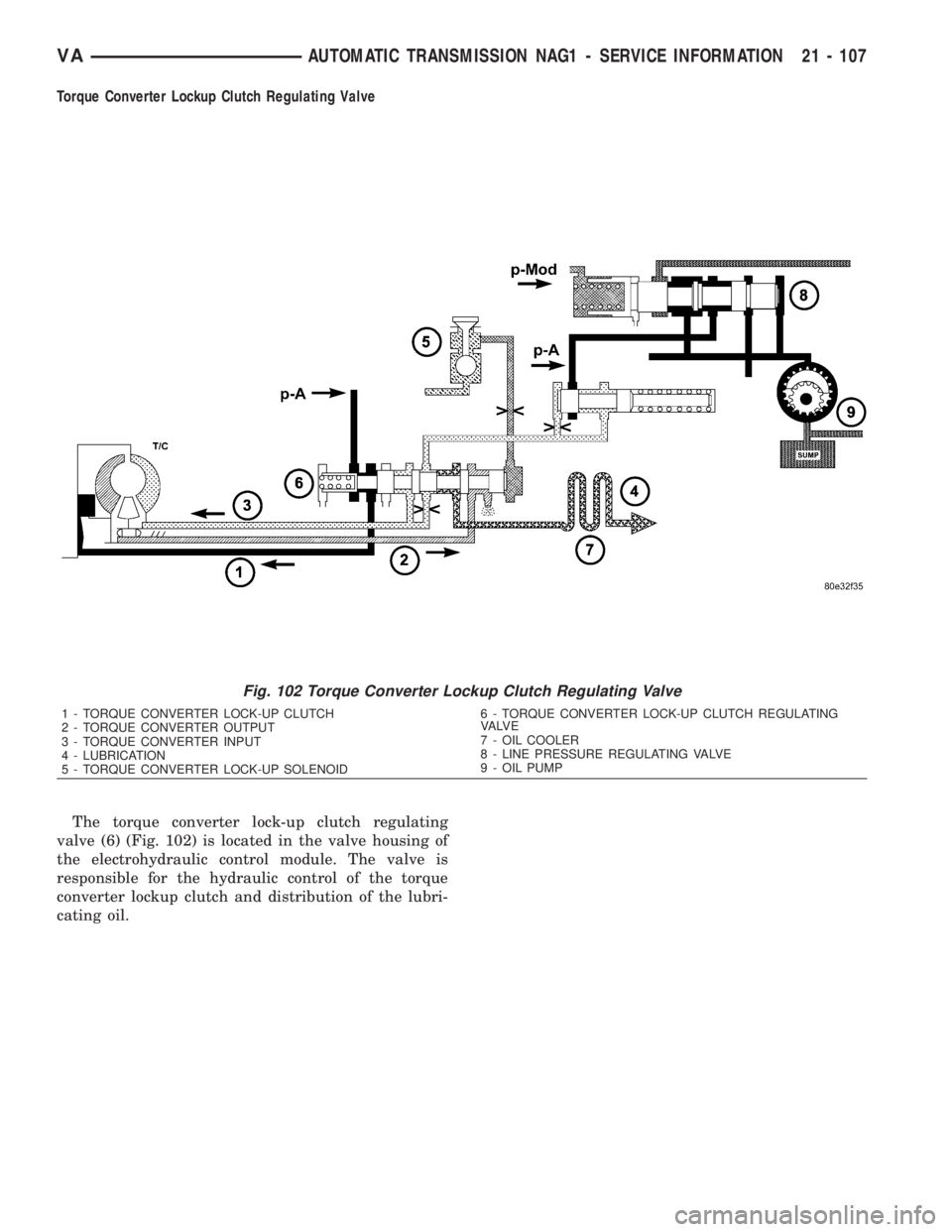
Torque Converter Lockup Clutch Regulating Valve
The torque converter lock-up clutch regulating
valve (6) (Fig. 102) is located in the valve housing of
the electrohydraulic control module. The valve is
responsible for the hydraulic control of the torque
converter lockup clutch and distribution of the lubri-
cating oil.
Fig. 102 Torque Converter Lockup Clutch Regulating Valve
1 - TORQUE CONVERTER LOCK-UP CLUTCH
2 - TORQUE CONVERTER OUTPUT
3 - TORQUE CONVERTER INPUT
4 - LUBRICATION
5 - TORQUE CONVERTER LOCK-UP SOLENOID6 - TORQUE CONVERTER LOCK-UP CLUTCH REGULATING
VA LV E
7 - OIL COOLER
8 - LINE PRESSURE REGULATING VALVE
9 - OIL PUMP
VAAUTOMATIC TRANSMISSION NAG1 - SERVICE INFORMATION 21 - 107
Page 1855 of 2305
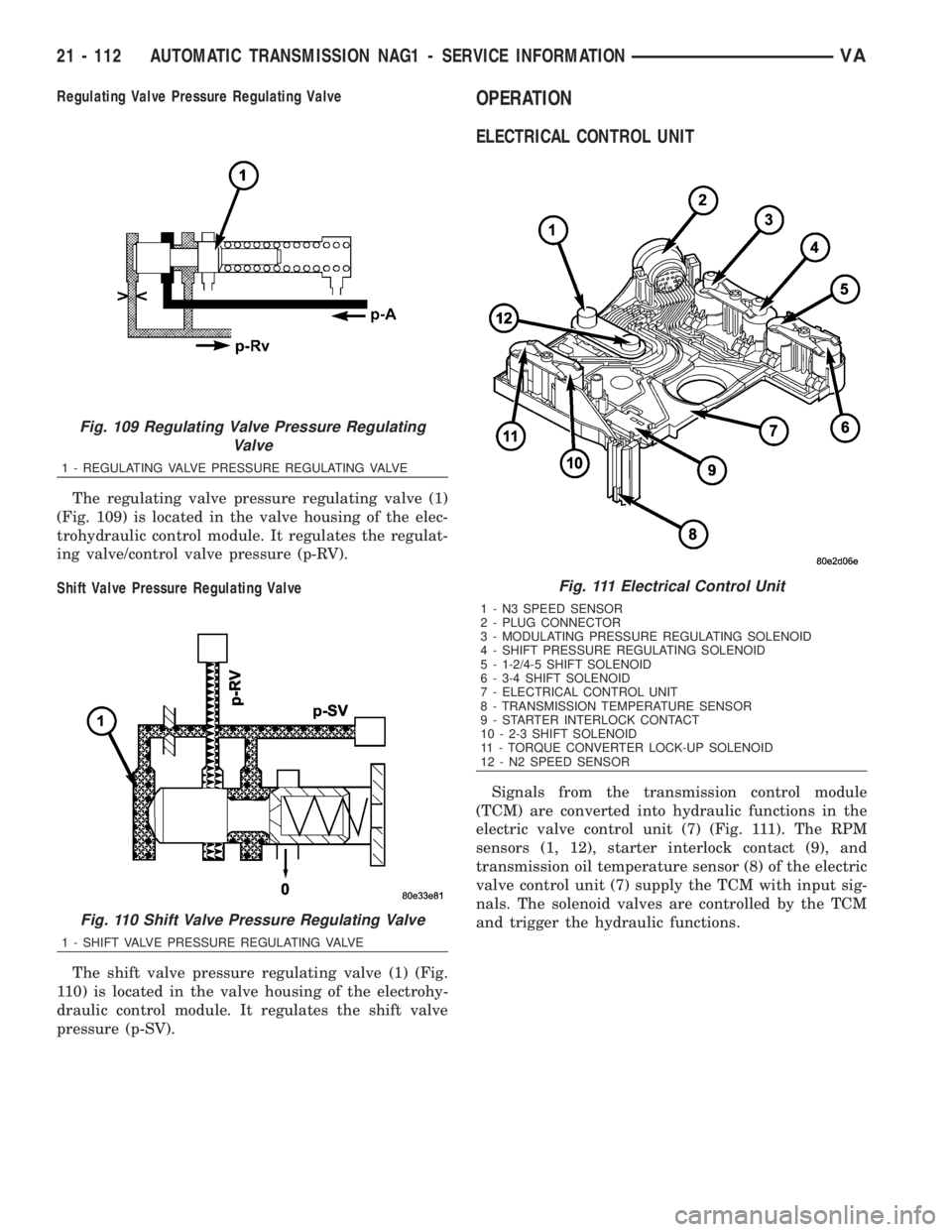
Regulating Valve Pressure Regulating Valve
The regulating valve pressure regulating valve (1)
(Fig. 109) is located in the valve housing of the elec-
trohydraulic control module. It regulates the regulat-
ing valve/control valve pressure (p-RV).
Shift Valve Pressure Regulating Valve
The shift valve pressure regulating valve (1) (Fig.
110) is located in the valve housing of the electrohy-
draulic control module. It regulates the shift valve
pressure (p-SV).OPERATION
ELECTRICAL CONTROL UNIT
Signals from the transmission control module
(TCM) are converted into hydraulic functions in the
electric valve control unit (7) (Fig. 111). The RPM
sensors (1, 12), starter interlock contact (9), and
transmission oil temperature sensor (8) of the electric
valve control unit (7) supply the TCM with input sig-
nals. The solenoid valves are controlled by the TCM
and trigger the hydraulic functions.
Fig. 109 Regulating Valve Pressure Regulating
Valve
1 - REGULATING VALVE PRESSURE REGULATING VALVE
Fig. 110 Shift Valve Pressure Regulating Valve
1 - SHIFT VALVE PRESSURE REGULATING VALVE
Fig. 111 Electrical Control Unit
1 - N3 SPEED SENSOR
2 - PLUG CONNECTOR
3 - MODULATING PRESSURE REGULATING SOLENOID
4 - SHIFT PRESSURE REGULATING SOLENOID
5 - 1-2/4-5 SHIFT SOLENOID
6 - 3-4 SHIFT SOLENOID
7 - ELECTRICAL CONTROL UNIT
8 - TRANSMISSION TEMPERATURE SENSOR
9 - STARTER INTERLOCK CONTACT
10 - 2-3 SHIFT SOLENOID
11 - TORQUE CONVERTER LOCK-UP SOLENOID
12 - N2 SPEED SENSOR
21 - 112 AUTOMATIC TRANSMISSION NAG1 - SERVICE INFORMATIONVA
Page 1857 of 2305
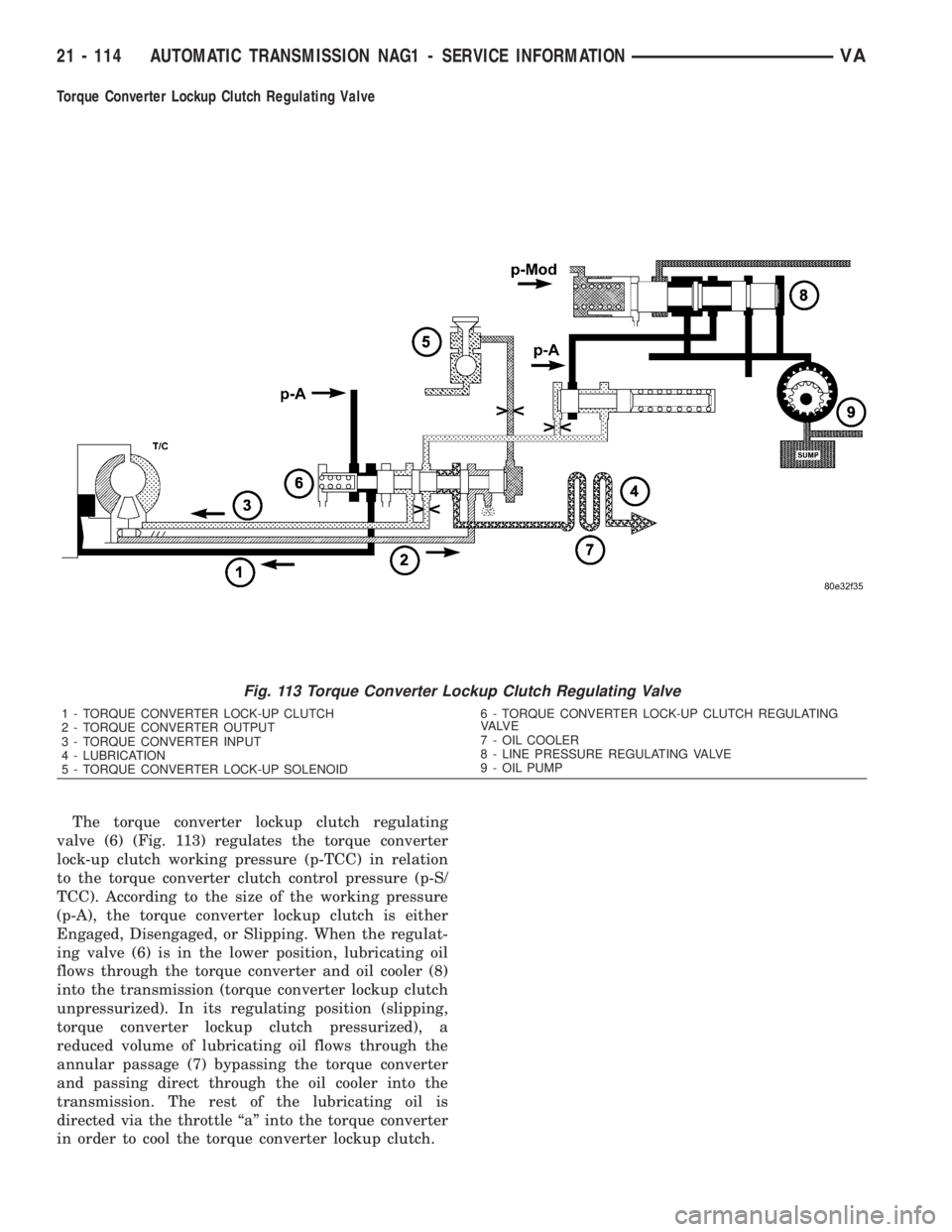
Torque Converter Lockup Clutch Regulating Valve
The torque converter lockup clutch regulating
valve (6) (Fig. 113) regulates the torque converter
lock-up clutch working pressure (p-TCC) in relation
to the torque converter clutch control pressure (p-S/
TCC). According to the size of the working pressure
(p-A), the torque converter lockup clutch is either
Engaged, Disengaged, or Slipping. When the regulat-
ing valve (6) is in the lower position, lubricating oil
flows through the torque converter and oil cooler (8)
into the transmission (torque converter lockup clutch
unpressurized). In its regulating position (slipping,
torque converter lockup clutch pressurized), a
reduced volume of lubricating oil flows through the
annular passage (7) bypassing the torque converter
and passing direct through the oil cooler into the
transmission. The rest of the lubricating oil is
directed via the throttle ªaº into the torque converter
in order to cool the torque converter lockup clutch.
Fig. 113 Torque Converter Lockup Clutch Regulating Valve
1 - TORQUE CONVERTER LOCK-UP CLUTCH
2 - TORQUE CONVERTER OUTPUT
3 - TORQUE CONVERTER INPUT
4 - LUBRICATION
5 - TORQUE CONVERTER LOCK-UP SOLENOID6 - TORQUE CONVERTER LOCK-UP CLUTCH REGULATING
VA LV E
7 - OIL COOLER
8 - LINE PRESSURE REGULATING VALVE
9 - OIL PUMP
21 - 114 AUTOMATIC TRANSMISSION NAG1 - SERVICE INFORMATIONVA
Page 1862 of 2305
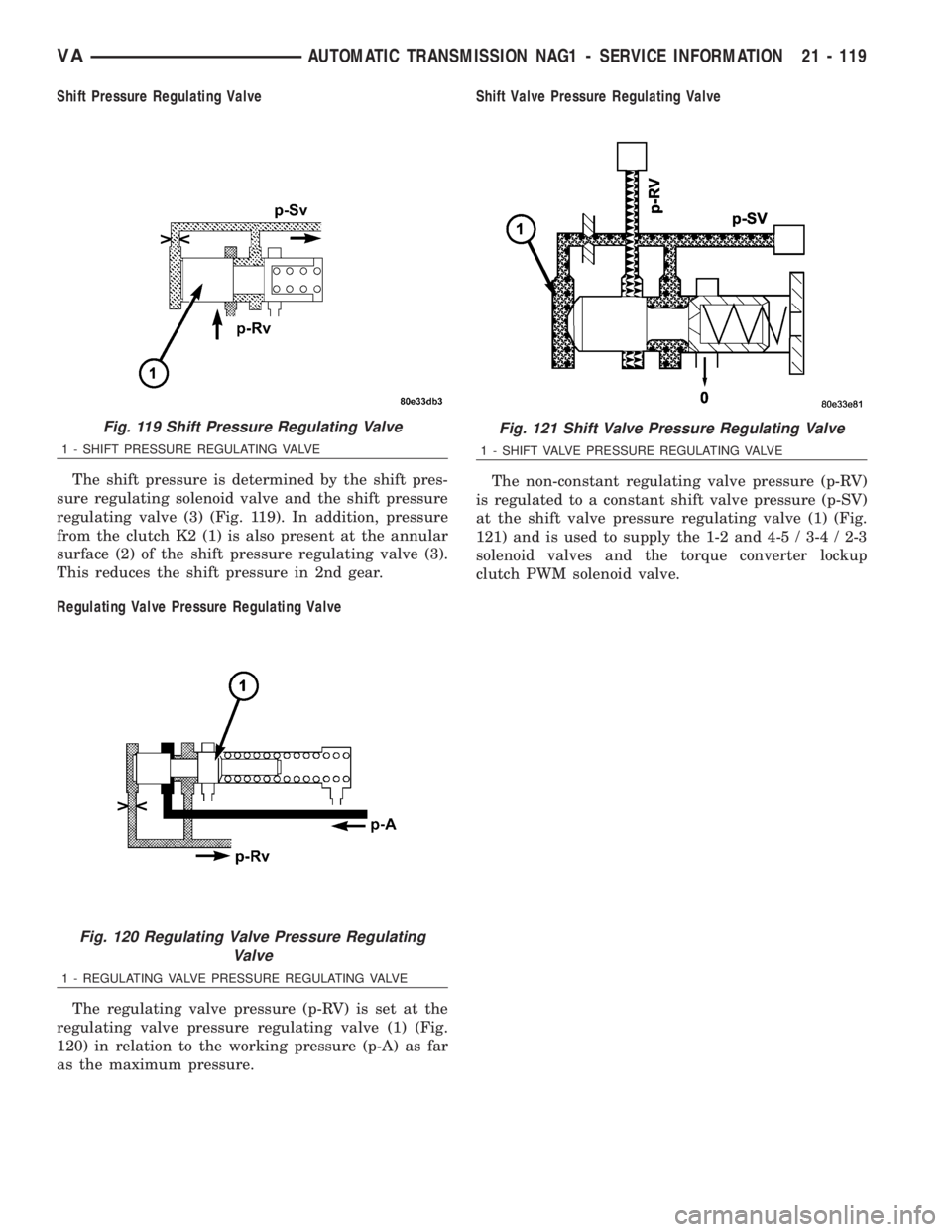
Shift Pressure Regulating Valve
The shift pressure is determined by the shift pres-
sure regulating solenoid valve and the shift pressure
regulating valve (3) (Fig. 119). In addition, pressure
from the clutch K2 (1) is also present at the annular
surface (2) of the shift pressure regulating valve (3).
This reduces the shift pressure in 2nd gear.
Regulating Valve Pressure Regulating Valve
The regulating valve pressure (p-RV) is set at the
regulating valve pressure regulating valve (1) (Fig.
120) in relation to the working pressure (p-A) as far
as the maximum pressure.Shift Valve Pressure Regulating Valve
The non-constant regulating valve pressure (p-RV)
is regulated to a constant shift valve pressure (p-SV)
at the shift valve pressure regulating valve (1) (Fig.
121) and is used to supply the 1-2 and 4-5 / 3-4 / 2-3
solenoid valves and the torque converter lockup
clutch PWM solenoid valve.
Fig. 119 Shift Pressure Regulating Valve
1 - SHIFT PRESSURE REGULATING VALVE
Fig. 120 Regulating Valve Pressure Regulating
Valve
1 - REGULATING VALVE PRESSURE REGULATING VALVE
Fig. 121 Shift Valve Pressure Regulating Valve
1 - SHIFT VALVE PRESSURE REGULATING VALVE
VAAUTOMATIC TRANSMISSION NAG1 - SERVICE INFORMATION 21 - 119